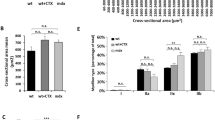Abstract
Muscle can be used for systemic delivery of non-muscle proteins. In order to investigate the relative effectiveness of direct DNA plasmid injection versus implantation of genetically modified myogenic cell lines, we have used the human alpha 1 anti-trypsin (α1AT) cDNA driven by either cytomegalovirus (CMV) or the muscle creatine kinase 3.3 kb (MCK) promoter in immunodeficient mice. We dem- onstrate that the implantation of transfected myoblasts stably expressing the human α1AT cDNA generates a more persistent production of α1AT than does direct intramuscular injection of the same construct as plasmid DNA. Moreover, immunohistological labelling of muscle sections implanted with myoblasts show that the newly formed muscle fibres are those containing the human protein.
This is a preview of subscription content, access via your institution
Access options
Subscribe to this journal
Receive 12 print issues and online access
$259.00 per year
only $21.58 per issue
Buy this article
- Purchase on Springer Link
- Instant access to full article PDF
Prices may be subject to local taxes which are calculated during checkout







Similar content being viewed by others
References
Partridge TA . Skeletal muscle as a target for gene therapy Gene Therapy 1994 1: 77–79
Dahler A et al. Expression vectors encoding human growth hormone (hGH) controlled human muscle-specific promotors: prospects for regulated production hGH delivered by myoblast transfer or intravenous injection Eur J Cell Biol 1994 45: 305–310
Miller G et al. Expression of factor VII by muscle cells in vitro and in vivo following direct gene transfer: modelling genetherapy for haemophilia Gene Therapy 1995 2: 736–742
Morral N et al. Immune responses to reporter protein and high viral dose limit duration of expression with adenoviral vectors: comparison of E2a wild-type and E2a-deleted vectors Hum Gene Ther 1997 8: 1275–1286
Wells KE et al. Immune responses, not promoter inactivation, are responsible for decreased long-term expression following plasmid gene transfer into skeletal muscle FEBS Lett 1997 407: 164–168
Yao S, Kurachi K . Implanted myoblasts not only fuse with myofibers but also survive as muscle precursor cells J Cell Sci 1993 105: 957–963
Chamberlain JS, Jaynes JB, Hauschka SD . Regulation of creatine kinase induction in differentiating mouse myoblast Mol Cell Biol 1985 5: 484–492
Levy M et al. Characterization of plasmid DNA transfer into mouse skeletal muscle: evaluation of uptake mechanism, expression and secretion of gene products into blood GeneTherapy 1996 3: 201–211
Schneider G et al. Genomic DNA transfer with a high-capacity adenovirus vector results in improved in vivo gene expression and decreased toxicity Nat Genet 1998 18: 180–183
Beauchamp JR et al. Dynamics of myoblast transplantation reveal a discrete minority of precursors with stem cell-like properties as the myogenic source J Cell Biol 1999 144: 1113–1122
Dai Y, Roman M, Naviaux RK, Verma IM . Gene therapy via primary myoblasts: long-term expression of factor IX protein following transplantation in vivo Proc Natl Acad Sci USA 1992 89: 10892–10895
Yao SN, Smith KJ, Kurachi K . Primary myoblast-mediated gene transfer: persistent expression of human factor IX in mice Gene Therapy 1994 1: 99–107
Wang JM, Zheng H, Blaivas M, Kurachi K . Persistent systemic production of human factor IX in mice by skeletal myoblast-mediated gene transfer: feasibility of repeat application to obtain therapeutic levels Blood 1997 90: 1075–1082
Coulton GR et al. The mdx mouse skeletal muscle myopathy: I. A histological, morphometric and biochemical investigation Neuropathol Appl Neurobiol 1988 14: 53–70
McMahon J et al. Inflammatory responses following direct injection of plasmid DNA into skeletal muscle Gene Therapy 1998 5: 1283–1290
Nehls M et al. New members of the winged-helix protein family disrupted in mouse and rat nude mutations Nature 1994 372: 103–107
Messina J, Gilkeson G, Pisetsky D . Stimulation of in vitro murine lymphocytes proliferation by bacterial DNA J Immunol 1991 147: 1759–1764
Krieg A et al. CpG motifs in bacterial DNA trigger B cell activation Nature 1995 374: 546–549
Manthorpe M et al. Gene therapy by intramuscular injection of plasmid DNA: studies on firefly luciferase gene expression in mice Hum Gene Ther 1993 4: 419–431
Hartikka J et al. An improved plasmid DNA expression vector for direct injection into skeletal muscle Hum Gene Ther 1996 7: 1205–1217
Qin L et al. Promoter attenuation in gene therapy: interferon-gamma and tumor necrosis factor-alpha inhibit transgene expression Hum Gene Ther 1997 8: 2019–2029
Harms JS, Splitter GA . Interferon-gamma transgene expression driven by SV40 or CMV promoters but augments expression driven by the mammilian MHC I promoter Hum Gene Ther 1995 6: 1291–1297
Morgan JE et al. Myogenic cell lines derived from transgenic mice carrying a thermolabile T antigen: a model system for the derivation of tissue-specific and mutation-specific cell lines Dev Biol 1994 162: 486–498
Partridge TA et al. Conversion of mdx myofibres from dystrophin-negative to -positive by injection of normal myoblasts Nature 1989 337: 176–179
Wells DJ . Improved gene transfer by direct plasmid injection associated with regeneration in mouse skeletal muscle FEBS Lett 1993 332: 179–182
Acknowledgements
The authors would like to thank Dr Peter Strong for the P6 antibody, Jamie Morrison for technical assistance, Kim Wells for performing the CK assay and critical reading of the manuscript.
Author information
Authors and Affiliations
Rights and permissions
About this article
Cite this article
Bou-Gharios, G., Wells, D., Lu, Q. et al. Differential expression and secretion of alpha 1 anti-trypsin between direct DNA injection and implantation of transfected myoblast. Gene Ther 6, 1021–1029 (1999). https://doi.org/10.1038/sj.gt.3300933
Received:
Accepted:
Published:
Issue Date:
DOI: https://doi.org/10.1038/sj.gt.3300933
Keywords
This article is cited by
-
Non-viral gene delivery in skeletal muscle: a protein factory
Gene Therapy (2003)
-
Gene therapy: principles and applications to hematopoietic cells
Leukemia (2001)



